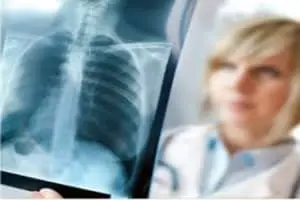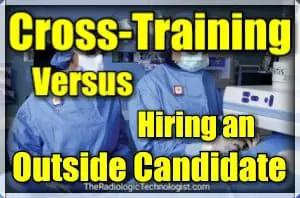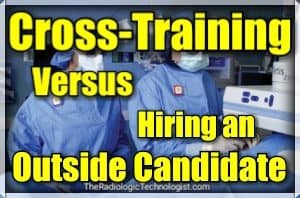Is it better to cross-train current employees instead of hiring skilled workers outside the company?
Positives
- Internal training increases employee morale as they reward for their exemplary work.
- Employees already know the environment (computer systems, departmental locations, staff, etc.)
- Viewing this as a career ladder, cross-training promotes employee engagement and leadership.
- Management invests in staff, which breeds loyalty.
- Creates staff who are now multi-modality technologists are training is complete.
- Cross-train pay remains at the prior modality rate, lower than hiring an experienced tech from outside.
- Once licensed, the cross-trained employee’s salary, although higher than the previous one, is lower than an experienced new hire.
Negatives
- This will create a gap in the modality where the trainee is coming from (usually general x-ray).
- Higher costs associated with internal cross-training, depending on the modality
- It takes longer for receiving department to get the help they may need.
- The newly trained employee could leave for greener grass-up cross-training completion.
Two options exist for replacing or increasing the number of specialized technologists to meet the demand. You may cross-train current employees for the job or hire a skilled person from outside the company.
Each option entails multiple positive and negative attributes. So, what does each mean for your radiology department, and which is the best option? Sometimes, there are ways to mitigate and neutralize the negative aspects.
Here is an in-depth analysis of the choices, their pros and cons, and why it is a great idea to start thinking of cross-training rad techs to become advanced modality technologists. Fundamentally, you have to start with the question:
What Does Cross-Training an Employee Mean?
Cross-training is when you teach your current employee the skills and responsibilities of a different position within your company. It is a common practice among companies that want to increase the efficiency of their employees while promoting loyalty and career growth.
Over the years, it mainly ensured the smooth running of companies by having someone step in when a specific employee could not make it to their work. The company remains profitable even when key employees call in sick, go on leave for vacations or quit the company entirely.
It also popularized cutting costs by having employees perform multiple roles depending on the demand. Night shift employees are a perfect example of the benefits to employees being multi-modality trained and utilized when volumes are low.
Cross-training also comes in handy when one section is overwhelmed by the amount of work due to an unexpected volume increase. When mass casualties flood a Level One trauma center, cross-trained employees can move from modality to modality as needed.
Certified radiologic technologists can, therefore, cross-train to become proficient and get a license within many different modalities throughout the department.
How Do You Cross-Train Employees in a Radiology Department?
The question that often pops up is, who will train them? What about examination and certification? Luckily, a system currently exists to ensure the technologists you cross-train are of the highest attainable standards after completing the cross-training.
But first, when do you train, and how do you choose the employees to train? The best time to train an employee is BEFORE a position becomes available due to increased demand for the modality services.
The employee you choose needs to have shown exemplary worth ethic is hardworking, and qualifies for a promotion. Waiting until the position opens could set a department up for a staffing squeeze. By that, I mean if a position suddenly came open in MRI and you selected a candidate from general X-ray to cross-train, you could leave understaffed in your X-ray department.
Think ahead and plan to cross-train employees for modalities where you have seen the highest turnover or where you can forecast employees leaving due to retirement, repeated corrective actions, or other indicators.
Teaching a new modality to the existing rad tech will involve the following steps:
1. Learning on the Job

One thing that makes cross-training effective is that the trainee learns on the job under the supervision of a qualified technologist. They can assist the trainer in the daily running the services as they learn. The trainer is the technologist specialized in that modality, for instance, a CT, MRI, or US tech. An advantage to the trainer is that they get help with the work right from the beginning as they share their knowledge and experience. While the trainer may have to slow down a little to explain things to the trainee, this also reinforces the knowledge held by the trainer as they have to explain the “why” behind the work.
A trainee will assist in doing the scans, and as they proceed, they will get to a point where they understand the software enough to compile the scans. In this first step, they need to accomplish the following:
· Ability to analyze and perform critical thinking skills
· Understand the pathology related to this new modality
· Understand the software platform in use and the machine
· Learn about the protocols and what the radiologist needs to see to provide the best images
While the trainee learns the above concepts and works on doing procedures, they can begin the next phase.
2. Online Education
The trainee must acquire a certain number of credits through online education. For instance, if a rad tech trains to become a CT tech, they must do online education for 16 credits. ASRT is the primary provider of this online learning. Your trainee can also opt for other education sources if they satisfy the 16-credit structured ARRT education requirements for CT.
During this stage, the trainee will learn about the development of CT scanning, how CT equipment works, and medical imaging applications. As mentioned earlier, they need to understand pathology more; thus, they will learn the identification of pathologies on CT images and the probable causes. Teach patients safety and high image quality in the online series.
MRI, IR, and Dexa modalities also have their specific ARRT structure to meet the credit requirements. Ultrasound is governed by the ARDMS, and Nuclear Medicine by the NMTBE.
Although, you will not be able to cross-train an NM Tech like the other modalities. You will have to send your trainee back to school and cross-train under the guise of clinical rotations while your trainee attends an accredited NM program. Your trainee will need to complete online education before they proceed to certification.
3. ARRT Registry
A final step in the cross-training is the certification and registration by ARRT as a qualified professional for the specific field. The trainee will sit for the ARRT registry exam, and once they pass, they will receive the certification and registration.
These exams are difficult, and trainees will benefit if you send them to additional informative seminars on preparing for board exams.
Once registered, the title R.T. (CT), R.T. (MRI), R.T. (CV), or R.T. (BD) is acquired, and the trainee is now a specialist in that field. R.T. stands for Registered Technologist, and the letters in the brackets represent the modality in which one is a specialist: Computed Tomography, MRI, CardioVascular interventional radiology, or Bone Densitometry.
Why Should You Cross-Train Employees?
Never has there been a better time to cross-train than now. Your employees form a resource pool with high potential, and cross-training utilizes that potential to move the department to the next level. Cross-training addresses current challenges and cushions your department against future problems.
In dealing with current challenges, cross-training will allow you to plan for future staffing shortages. Waiting too long to cross-train, you may find yourself in a situation where your current staff works too much and become unhappy with a staffing shortage.
You can comfortably let your key employees have their leaves and vacations when you have someone to stand in for them during that period. Efficiency thus achieves as every employee will be at their best.
One of the ways to prepare for the unpredictable future is by cross-training. You will stay afloat when a key employee decides to quit or terminate for one reason or another, as an employee cross-trained in that field will pick up immediately.
That also applies to accidents, ill health, or any other unavoidable circumstance that leaves a modality without a technologist and understaffed. With cross-training, you will always be future-proof and allow your employee’s upward mobility in their jobs.
What are the Benefits of Cross-Training Employees?
The pros of cross-training include the following:
Increases Morale

Employees enjoy working in a place where promotions are possible. Cross-training allows them to advance in their careers and therefore boosts their morale. They will feel their work is appreciated, and you should see a correlation in your employee culture survey scores.
The morale increases among those who get a different position after the training and those still waiting to advance. Those waiting will know that when they put in the work, they will recognize and promoted when a position is available.
On the contrary, having them stuck in their current positions while people from outside fill vacancies will kill their morale and affect productivity in the department.
Staff Already Know Each Other
One of the main challenges to new employees being productive is the dynamics of joining the existing workforce. It even gets more challenging when they are joining at a superior position, and it may take some time before everything gets back to normal. The outcome of the dynamics is a bump in productivity because the staff are already acquainted and have worked together at some level.
Cross-training employees aids in a smooth transition as the staff already know each other. They will efficiently work together even in the new capacity. Service delivery is, therefore, not affected. Their ability to work well together means production remains stable if not boosted.
Cheaper in the Long Run
Although the cost of training in terms of time and finances may be higher than getting a skilled person, it is cheaper to cross-train in the long run. When you cross-train, the employee steps into the new position with a salary enhancement. As probably the main change. Hiring a skilled professional will mean a higher annual salary as their experience also comes into play immediately upon hire.
Over a long-term run rate, a skilled outside employee will cost more than a cross-trained, loyal internal employee.
Employee Already Knows Your EMR, Policies, and Procedures
Every facility has policies, procedures, and Electronic Medical Records that are specific to them. If you were to recruit from outside, the new employee would have to be taught all these specifics to enable them to work in their new capacity. On the other hand, cross-training allows you to utilize an employee who already understands the standard operating procedures and other things specific to the department.
An employee transitioning to the new capacity will have a basic understanding right from the moment they enter the new position. You do not have to worry about orienting them to commonalities like EMR, general policies, etc. These will carry over from their previous modality.
Rewards Staff for Loyalty and Hard Work
As mentioned earlier, the employee to cross-train works hard and shows an impressive work ethic. Cross-training is thus an effective way of rewarding the staff for their hard work in their current capacities with more recognition and better pay. It motivates others and, therefore, boosts your productivity.
Every department should reward and recognize the loyalty of employees who stay in your department and offer unwavering quality work. They should reward them through cross-training for new positions like CT and MRI techs. When you reward loyalty, you inspire the employees to stay with your department for longer, and thus, you don’t lose great potential.
Use the standard interview method and develop a scoring rubric for picking the winning candidate. Consider the following as measuring criteria:
- Length of time with the company (also known as seniority).
- Employee file, devoid of corrective actions in the previous year.
- Interview outcome, how did they interview? Was there a sincere desire to learn and grow?
- In previous annual evaluations, are they team players?
Opens Up a New Job
The employee taking up a new position will leave their previous post vacant. That makes available a new job at the bottom that a graduate from a local X-ray school can be hired to fill. It is easier and better to cross-train for higher positions and recruit for lower jobs, especially if you host local students in clinical rotations.
Hiring at the lower positions also allows you to recruit the talent you can nurture and later cross-train to cover the specialized fields when needed. It fosters continuity.
Training Future Trainers
When you cross-train, you get great employees for the new positions and prepare them to pass on the knowledge. Cross-training makes them better future trainers; thus, you kill two birds with one stone. Your department should ensure quality personnel for as long as it exists because the trainees are equipped to train the next group.
An impressive thing about training someone is that it also increases the trainer’s expertise. The department thus improves rapidly in the expertise of both trainers and trainees.
Job Security
Finally, there is better job security for cross-trained employees. They can fit into more than one field, meaning the chance of being jobless is minimal. When a department cuts costs by cutting the employee size, the people most likely to remain are those with cross-training in a different field.
As administrators, we never like to see a reduction in the workforce. But without a doubt, the employees who are more difficult to release can work in multiple areas throughout the hospital.
Cons of Cross-Training
Cost of Training

If you backfill the vacated position where the trainee came from, it will cost more initially to cross-train than to hire outside, although the cost is lower later on when compared. In this scenario, you are paying both the trainee and the backfill. However, this is a net neutral to your budget as before the need for cross-training, you were already paying someone to work in the advanced modality. You cannot fill all the needs with cross-training if multiple needs occur simultaneously in one advanced modality.
Hire from outside to get the department back operational, and you won’t have the time to cross-train.
Less Experience
The cross-trainee will have almost no experience as a specialist in the field as opposed to someone new who may have years of experience in the area at the time of hiring.
Unhealthy Competition
As with most promotions, unhealthy competition may arise between the employees. The senior registered technologists in the modality you want to cross-train may also feel threatened by new hires, negatively impacting productivity.
Should You Get Paid for Cross-Training?
It all depends on the facility. You can get paid when you are training on the job. It is the best option for trainees as it smooths the transition, especially financially. You also may need to be paid due to employer policy. Many facilities cannot allow technologists to see patient information or work hands-on with patients if they are not actively on the clock.
However, some facilities can cross-train during evening shifts when patient volume is low. Training an X-ray tech to do CT scans when no X-rays are performed is financially responsible. Still, it can make it difficult for the trainee to learn concepts as they are constantly pulled back to their original department whenever a new exam is ordered.
You will not get paid if you do it as a student during your clinical rotations outside your work shift. Student clinical rotations are more akin to volunteer work, and the school policies govern the student. There are instances where hospitals can hire students before they complete their schooling. In this case, you are a hired employee finishing clinical hours.
Administrators like student clinical rotations as it allows an evaluation period of the potential future candidate for employment. Clinical rotations are known to be pseudo-job interviews.
Is it Better to Hire an Outside Candidate?
Now that you understand cross-training, what about hiring from outside? Is it better? Hiring an individual from outside the company has its merits and demerits, as shown below:
Pros of Hiring from Outside the Company
Already Has Modality Experience
Perhaps the greatest advantage is that the new employee already has experience in the job you are offering. As you know, the more you do as a technologist, the better you become. The years in the field mean unparalleled expertise your department gains by hiring.
With experience, a technologist can spend less time on each scan to get to what the radiologist will need to see in less time. That means more scans can be done; thus, the department earns more for the facility or business. It is, however, not the case for a starter who has been cross-trained as they try to find their way around in the new modality.
Can Hit the Ground Running
The R.T. you hire can start immediately and deliver from day one. While cross-training will need time for the training and ease into the job, hiring from outside will allow you to get the right person for the job immediately. They still have to learn the current EMR, PACS system, and other software, but the fundamentals of scanning are there. There is also a chance that their prior employer used the same software.
Hiring will, therefore, be essential when it comes to replacing a key employee who quits, is terminated, or cannot show up right away. Cross-training requires the modality to have at least one technologist who will carry out the training. At the same time, hiring allows you to fill the vacancy and get the modality running immediately.
New Energy
Hiring can inject new energy into the department and transform it entirely when someone from outside is hired. They will bring better alternatives and can be a source of significant improvements. They might be what your department needs to get to the next level. “Fresh eyes,” as they call it, can benefit a stale department.
Cons of External Hiring
Little Knowledge of the Hospital
A new employee will have little knowledge of the hospital and department and will, therefore, have a long time settling down. There are procedures, policies, and EMR to learn before they can comfortably deliver in their position.
Besides being challenging for the employee, the department will be unable to get the best out of the new employee in the early months. Given the critical role the radiology department plays in the hospital regarding income, the adaptation period may negatively affect the hospital.
Don’t Know the Computer System in Use
Facilities tend to have customized software for the operation of their machines. An individual hired from outside will thus have a steep learning curve. It may take some serious orientation to get them adapted to the computer system in use.
An employee used to scanning on GE equipment may have to learn Siemens equipment and change their scanning protocols altogether. While the basics are still there, the workflow to achieve the scans could be completely different.
Cross-training counters this problem by having the candidate train on the job and hence will understand the system well by the time of assumption of the specialist role.
Have to Earn Respect
The dynamics of joining a new peer group come into play and may be challenging for the hired employee. It may take some time to earn the respect of the new peer group, which will allow a smooth flow at work.
It even gets more challenging if the person being replaced has made a name for themselves among the employees. The new employee will have to work hard to fit in their predecessor’s shoes.
Low Morale among Employees
When nobody looks forward to promotions because the employer will hire someone from outside, the department suffers low morale. External hiring reduces the career ladder of the employees, and thus, they may not perform at their best.
New Employee May Not Work Out/ Fit in
There is a risk of the new employee not fitting into the position. They may survive the interviewing, screening, hiring, and other procedures but not fit into the new position. Whatever the cause of not working out, you will suffer a significant loss of time and money if you have to let them go and hire another one. This is the purpose of a 90-day evaluation period.
Sometimes, the new position may be too different from what they expected, and after struggling for a while, they may decide to quit.
Comparison of the Cost of Cross-Training vs. External Hiring
Studies show that hiring new employees cost as high as 50-60% of their annual salary, which is way higher than training a current employee in a new skill and responsibility. (source). Cross-training costs only a fraction of the cost of hiring a new employee in the long run, which makes it cost-efficient.
However, in the beginning, cross-training may seem to cost more as the trainee is paid while they learn on the job. The trainer may need salary enhancement if the training impacts their job description. Hiring, on the other hand, will cost less at the beginning (if there is backfilling, as previously mentioned) but surpass the cost of cross-training in the long run.
Conclusion
As you can see, cross-training is superior to external hiring when filling a vacancy in advanced modalities. It has many advantages, including lesser run-rate costs, better employee morale, smoother transition, etc.
Hiring from outside is only optimal when immediate replacement is needed and no one else to train in-house. You can cross-train in anticipation of future staff shortages and forecasted patient volume increases, and your staff will appreciate it. And who couldn’t use better employee survey results?


